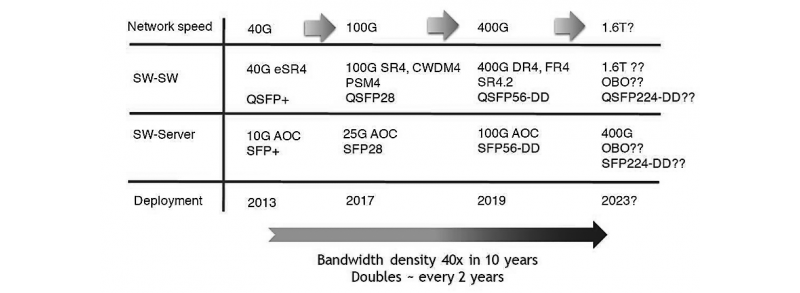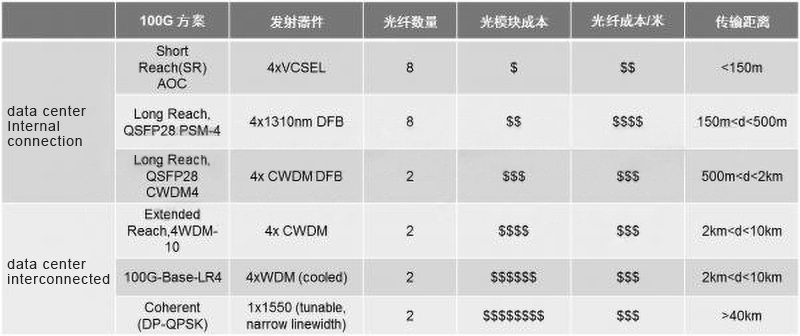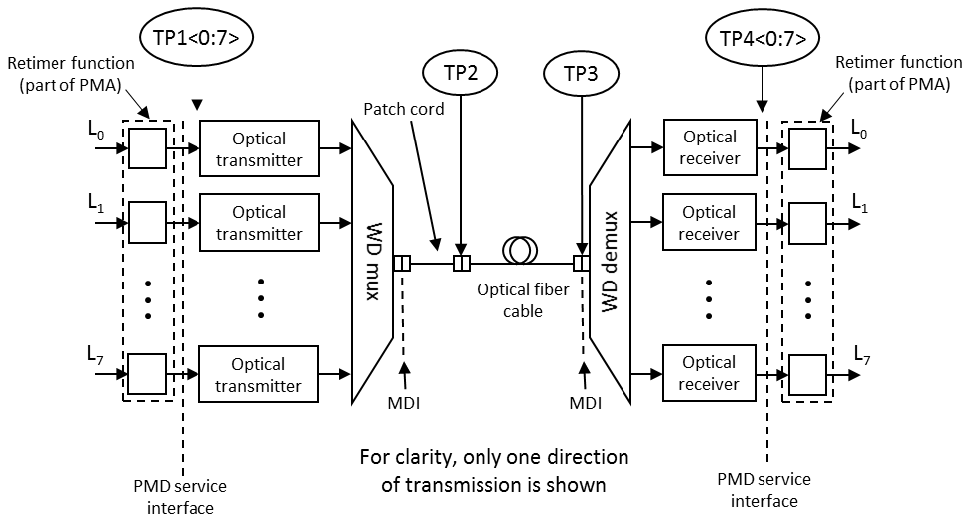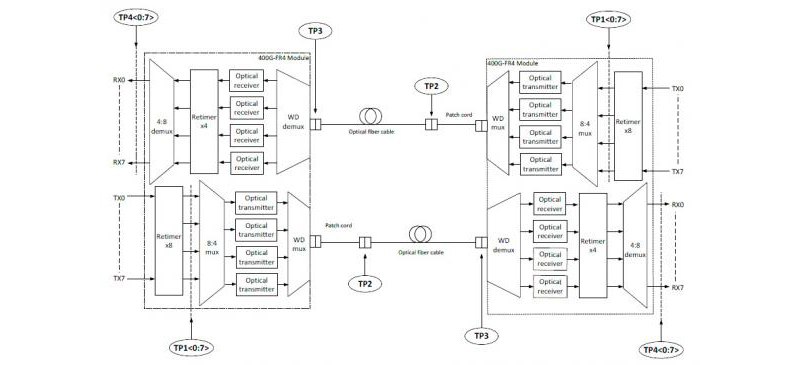“Network” has become a “necessity” for most contemporary people.
The reason why such a convenient network era can come, “fiber-optic communication technology” can be said to be indispensable.
In 1966, the British Chinese sorghum proposed the concept of optical fiber, which ignited the climax of developing optical fiber communication worldwide.The first generation of lightwave systems operating at 0.8 μm in 1978 was officially put into commercial use, and the second generation of lightwave communication systems using multimode fiber in the early days was quickly introduced in the early 1980s.By 1990, the third-generation optical wave system operating at 2.4 Gb/s and 1.55 μm was able to provide commercial communication services.
The “father of fiber” sorghum, who made a breakthrough contribution to “the transmission of light in fiber for optical communication,” was awarded the 2009 Nobel Prize in Physics.
Optical fiber communication has now become one of the main pillars of modern communication, playing a pivotal role in modern telecommunication networks. It is also seen as an important symbol of the world’s new technological revolution and the main means of transmission of information in the future information society.
In recent years, the application market of big data, cloud computing, 5G, Internet of Things and artificial intelligence has developed rapidly. The unmanned application market that is coming is bringing explosive growth to data traffic. Data center interconnection has gradually developed into optical communication research. hot spot.
 Inside Google’s large data center
Inside Google’s large data center
The current data center is no longer just a single or a few computer rooms, but a set of data center clusters.In order to achieve the normal work of various Internet services and application markets, data centers need to work together.The real-time and massive interaction of information between data centers has created the demand for data center interconnection networks, and optical fiber communication has become a necessary means to achieve interconnection.
Unlike traditional telecom access network transmission equipment, data center interconnection needs to achieve more information and more dense transmission, which requires switching equipment to have higher speed, lower power consumption, and more miniaturization.One of the core factors that determine whether these capabilities can be achieved is the optical transceiver module.
Some basic knowledge about optical transceiver modules
The information network mainly uses optical fiber as the transmission medium, but the current calculation and analysis must also be based on electrical signals, and the optical transceiver module is the core device for realizing photoelectric conversion.
The core components of the optical module are Transimitter (Light Emitting Submodule)/Receiver (Light Receiving Submodule) or Transceiver (Optical Transceiver Module), electrical chip, and also include passive components such as lenses, splitters, and combiners. Peripheral circuit composition.
At the transmitting end: the electrical signal is converted into an optical signal by Transimitter, and then input to the optical fiber by the optical adapter;At the receiving end: the optical signal in the optical fiber is received by the Receiver through the optical adapter and converted into an electrical signal and sent to the computing unit for processing.
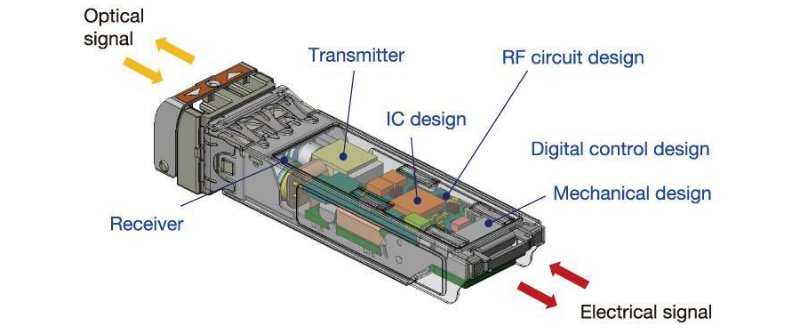
Optical transceiver module schematic
With the development of optoelectronic integration technology, the packaging form of the optical transceiver module has also undergone some changes. Before the optical module industry was formed, it was developed by the major telecom equipment manufacturers in the early days. The interfaces were varied and could not be used universally. This made the optical transceiver modules not interchangeable.For the development of the industry, the final “Multi Source Agreement (MSA)” came into being. With the MSA standard, companies that independently focused on developing Transceiver began to emerge, and the industry rose.
The optical transceiver module can be divided into SFP, XFP, QSFP, CFP, etc. according to the package form:
· SFP (Small Form-factor Pluggable) is a compact, pluggable transceiver module standard for telecom and datacom applications that supports up to 10Gbps transfer rates.
The XFP (10 Gigabit Small Form Factor Pluggable) is a 10G-rate small form factor pluggable transceiver module that supports multiple communication protocols such as 10G Ethernet, 10G Fibre Channel, and SONETOC-192.XFP transceivers can be used in the data communications and telecommunications markets and offer better power consumption characteristics than other 10Gbps transceivers.
QSFP (Quad Small Form-factor Pluggable) is a compact, pluggable transceiver standard for high-speed data communication applications. According to the speed, the QSFP can be divided into 4×1G QSFP, 4×10GQSFP+, 4×25G QSFP28 optical modules. Currently QSFP28 has been widely used in global data centers.
· CFP (Centum gigabits Form Pluggable) is based on a standardized dense wave optical splitting communication module with a transmission rate of 100-400 Gbps. The size of the CFP module is larger than that of the SFP/XFP/QSFP, and is generally used for long-distance transmission such as a metropolitan area network.
Optical transceiver module for data center communication
Data center communication can be divided into three categories according to the type of connection:
(1) The data center to the user is generated by the end user behavior such as browsing the webpage, sending and receiving emails and video streams by accessing the cloud;
(2) Data center interconnection, mainly used for data replication, software and system upgrades;
(3) Inside the data center, it is mainly used for information storage, generation and mining. According to Cisco’s forecast, data center internal communication accounts for more than 70% of data center communication, and the development of data center construction has spawned the development of high-speed optical modules.
The data traffic continues to grow, and the data center’s large-scale and flattening trend is driving the development of optical modules in two aspects:
· Increased transmission rate requirements
· Increase in quantity demand
At present, the requirements of global data center optical modules have changed from 10/40G optical modules to 100G optical modules.China’s Alibaba Cloud Promotion will become the first year of large-scale application of 100G optical modules in 2018. It is expected to upgrade 400G optical modules in 2019.
Ali cloud module evolution path
The trend of large-scale data centers has led to an increase in transmission distance requirements. The transmission distance of multimode fibers is limited by the increase in signal rate and is expected to be gradually replaced by single-mode fibers.The cost of the fiber link is composed of two parts: the optical module and the optical fiber. For different distances, there are different applicable solutions.For the medium to long distance interconnection required for data center communication, there are two revolutionary solutions born from MSA:
· PSM4(Parallel Single Mode 4 lanes)
· CWDM4(Coarse Wavelength Division Multiplexer 4 lanes)
Among them, the PSM4 fiber usage is four times that of CWDM4. When the link distance is long, the CWDM4 solution cost is relatively low. From the table below, we can see a comparison of the data center 100G optical module solutions:
Today, the implementation technology of 400G optical modules has become the focus of the industry.The main function of the 400G optical module is to improve the data throughput and maximize the bandwidth and port density of the data center.Its future trend is to achieve wide gain, low noise, miniaturization and integration, to meet the needs of next-generation wireless networks and ultra-large-scale data center communications applications.
The early 400G optical module used a 16-channel 25G NRZ (Non-Returnto Zero) signal modulation method in a CFP8 package.The advantage is that the 25G NRZ signal modulation technology matured on the 100G optical module can be borrowed, but the disadvantage is that 16 signals need to be transmitted in parallel, and the power consumption and volume are relatively large, which is not suitable for data center applications.In the current 400G optical module, 8-channel 53G NRZ or 4-channel 106G PAM4 (4 Pulse Amplitude Modulation) signal modulation is mainly used to realize 400G signal transmission.
In terms of module packaging, OSFP or QSFP-DD is used, and both packages can provide 8 electrical signal interfaces.In comparison, the QSFP-DD package is smaller in size and more suitable for data center applications; the OSFP package is slightly larger in size and consumes more power, making it more suitable for telecom applications.
Analyze the “core” power of 100G/400G optical modules
We have briefly introduced the implementation of 100G and 400G optical modules. The following can be seen in the schematic diagrams of the 100G CWDM4 solution, the 400G CWDM8 solution and the 400G CWDM4 solution: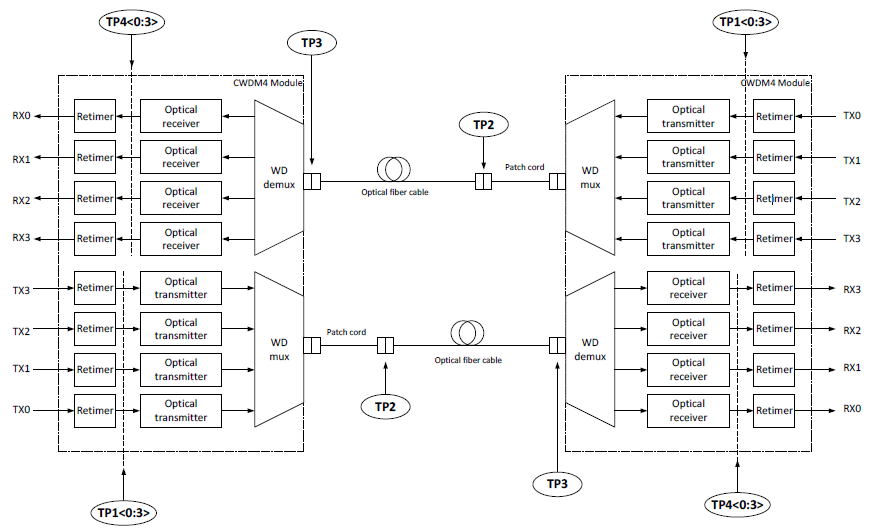
100G CWDM4 schematic
400G CWDM8 schematic
400G CWDM4 schematic
In the optical module, the key to realize photoelectric signal conversion is the photodetector. In order to finally meet these plans, what kind of needs do you need to meet from the “core”?
The 100G CWDM4 solution requires 4λx25GbE implementation, the 400G CWDM8 solution requires 8λx50GbE implementation, and the 400G CWDM4 solution requires 4λx100GbE implementation.Corresponding to the modulation method, the 100G CWDM4 and 400G CWDM8 schemes adopt NRZ modulation, which respectively correspond to the modulation rate of 25Gbd and 53Gbd devices.The 400G CWDM4 scheme adopts the PAM4 modulation scheme, which also requires the device to have a modulation rate of 53Gbd or more.
The device modulation rate corresponds to the device bandwidth. For a 1310nm band 100G optical module, a bandwidth 25GHz InGaAs detector or detector array is sufficient.






